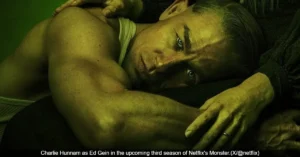The new season of Ryan Murphy’s Monster: The Ed Gein Story on Netflix suggests the infamous killer helped FBI agents understand Ted Bundy’s mind. While it makes for compelling television, this dramatic storyline is a complete work of fiction.
The series, which stars Charlie Hunnam as the notorious Wisconsin killer, creates a fictional narrative where investigators consult Gein to gain insights into other murderers. However, extensive historical records confirm that Ed Gein never assisted in any criminal investigations, including the Ted Bundy case.
The Fictional Storyline in “Monster”
In Monster: The Ed Gein Story, the series creates a plot where the FBI gains knowledge about other killers, including Ted Bundy, through conversations with Ed Gein. This fictional device suggests Gein provided psychological insights that helped authorities understand the minds of other serial killers.
The show even features a dream sequence where an older, sick Gein meets a group of copycat murderers who idolize him, further blending historical fact with dramatic fiction for entertainment purposes. This narrative choice aims to position Gein as an unwilling “case study” for understanding future murderers, though it has no basis in reality.
The Historical Facts About Ed Gein
The real Ed Gein, often called the Butcher of Plainfield, was a reclusive Wisconsin farmer whose horrific crimes were discovered in 1957. Authorities investigating the disappearance of hardware store owner Bernice Worden made gruesome discoveries at his farmhouse, including human skulls, masks made from skin, and chairs made of bones.
Gein confessed to killing two women—Bernice Worden and Mary Hogan. He also admitted to digging up numerous corpses from local cemeteries to collect body parts. He was found legally insane and was committed to a mental hospital in 1958, where he remained until his death in 1984.
The Reality of Gein’s Incarceration
Historical records clearly show that Ed Gein never left his institution after his commitment in 1958. He lived quietly under psychiatric care and rarely spoke publicly. There were no interviews, no consultations with law enforcement, and certainly no collaboration with federal agents.
The FBI’s Behavioral Science Unit, which later studied serial offenders like Bundy, was formed years after Gein’s confinement. During the 1970s when Bundy’s crimes unfolded, Gein was already permanently institutionalized with no involvement in any ongoing investigations.
Why the Bundy Connection Appears in the Show
The creators of Monster: The Ed Gein Story included the Bundy connection as a symbolic device rather than a historical account. The show uses this fictional relationship to explore how society attempts to understand evil and how notorious criminals can become twisted cultural icons.
As co-creator Ian Brennan explained about the series, “It really matters what you look at and the images and stories you consume. They do stick with you, and they do have an impact.” The Bundy storyline serves to highlight how Gein’s crimes influenced popular culture and criminology, rather than representing actual events.
What Parts of the Series Are Accurate?
While the Ted Bundy connection is fictional, other aspects of Monster: The Ed Gein Story reflect documented history:
His relationship with his mother, Augusta Gein: She was indeed dominating, extremely religious, and taught him to despise women.
The discovery of human remains at his home: Based on 1957 police reports, investigators truly found the horrific collection of body parts and human skin artifacts.
His mental health diagnosis: Gein was diagnosed with schizophrenia and found mentally unfit for trial.
His influence on popular culture: Gein truly inspired some of Hollywood’s most famous horror characters, including Norman Bates in Psycho, Leatherface in The Texas Chain Saw Massacre, and Buffalo Bill in The Silence of the Lambs.
The Show’s Examination of True Crime Fascination
The third season of the Monster anthology series continues the franchise’s exploration of whether monsters are born or made. In Gein’s case, the show presents evidence for both sides—he was raised by an abusive, fervently religious mother who isolated him from the world, but he also suffered from schizophrenia.
The series uses Gein’s story to examine America’s fascination with true crime and serial killers. Ryan Murphy noted that he wanted to explore “how every generation creates their own bogeyman” and how violence in media evolves as audiences become desensitized to it.
As the series suggests, the true monster might not just be the killer, but society’s obsession with sensationalizing their crimes. In one scene from the show, Gein himself points this out by saying to the camera, “You’re the ones who can’t look away.”
Also Read: Netflix’s New Ed Gein Series Divides Critics But Becomes a Streaming Hit










